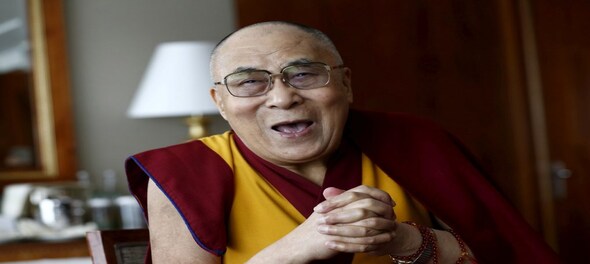
The 14th Dalia Lama, the spiritual leader and former head of state of Tibet, is landing in Jammu on July 14, before making his way to Ladakh for the first time in over four years. This is the first time that the Dalai Lama will visit the newly formed Union Territory after increased hostility at the Line of Actual Control (LAC). The spiritual leader is expected to stay in the region for a month when he will be meeting his followers, delivering sermons and meditating.
Predictably, the visit has already drawn flak from China’s Communist Party (CCP) leadership. Maintaining that the Dalai Lama is a “political exile disguised as a religious figure,” Chinese Foreign Ministry Spokesperson Zhao Lijian last week criticised Prime Minister Narendra Modi as well as US Secretary of State Antony Blinken for greeting the 14th Dalai Lama on the occasion of his 87th birthday.
"Tibet affairs are China's internal affairs, which brooks no foreign interference. China is firmly against any engagement by any country with the 14th Dalai Lama,” Zhao told a media briefing. Zhao added that “the Indian side should fully recognise the anti-China separatist nature of the 14th Dalai Lama.”
Tensions at the border
The arrival of the Dalai Lama, or Tenzin Gyatso as he is known spiritually, comes days ahead of the 16th round of talks between the Indian Army and the Chinese People's Liberation Army at the commander-corps level. The talks are part of the long ongoing disengagement process following the increased tensions at the LAC and the Galwan clashes of 2020.
The heightened tensions had finally culminated in a brawl in Galwan Valley, which resulted in the death of 20 Indian soldiers and 20-35 Chinese casualties, according to US sources. While partial disengagement had occurred in Galwan, Hot Springs, and Gogra, the military standoff still continues, with more than 50,000 troops deployed by either side.
China has long claimed large swathes of Indian territories, including Aksai Chin, Ladakh, Arunachal Pradesh and other smaller areas. As a result, the country is quick to criticise any travel from Indian leaders to these areas. But the visit of Gyatso to Ladakh, which China claims India had illegally set up, is expected to exacerbate tensions between the two.
China had been quick to criticise the Dalai Lama’s visit to Ladakh in 2018 as well. China views any official interaction with the Dalai Lama as a threat to its sovereignty as the country doesn't recognise the Dalai Lama as the head of state of Tibet. China’s discontent over any official interactions between the Dalai Lama and any Indian officials in the month-long trip may set back upcoming round of disengagement talks.
The itinerary
The Dalai Lama’s trip is his first major outing since the pandemic struck in 2020. Having mostly stayed put in Dharamshala’s Mcleodganj suburb, the spiritual leader was called to visit Ladakh at the behest of leaders like former MP Thupten Tsewang and other prominent Buddhist personalities such as Ladakh Buddhist Association President Thupstan Chewang and Thiksay Monastery’s Thiksay Rinpoche.
“His Holiness the Dalai Lama accepted the request of invitation made by the Ladakh Buddhist Association. The entire arrangement is being made by the Ladakh Buddhist Association and the local government,” Stanzin Konchok, Ladakh Autonomous Hill Development Council Councillor from Chushul, eastern Ladakh told the Indian Express.
“He will be staying at Choglamsar village on the banks of the Indus river and impart teaching to Buddhists and local communities. So far, it has not been decided how long he will stay there. We will know about that after he reaches the village that is at a high altitude. It depends on how he feels there,” said Tenzin Taklha, Gyatso’s personal secretary.
What India says
India’s response to Chinese criticism has been measured for the most part.
“It is a consistent policy of the government of India to treat His Holiness Dalai Lama as an honoured guest in India and as a respected religious leader who enjoys a large following in India,” Ministry of External Affairs Spokesperson Arindam Bagchi said when asked about the Chinese reaction to PM Modi’s greeting to the spiritual head at a media briefing.
India has hosted Gyatso in Dharamshala since 1959, when he arrived in India with his retinue to save himself from being killed, arrested or captured after the 1959 Tibetan uprising. Making his way to Dharamshala, the Dalai Lama set up the Tibetan government in exile and served as its political head. Soon after, hundreds of thousands of Tibetan refugees crossed over to India.
CCP interference
The terse relationship between Gyatso and the Chinese stems from the year 1950, when Chinese troops marched into Tibet to annex it after the signing of the Seventeen Point Agreement by the Tibetan government under duress from the Chinese military. While the Dalai Lama, aged under 20 at the time, toured China and met with leaders from the CCP, including Mao Zedong, his negotiations with officials over self-rule in Tibet met with little success.
Though the Dalai Lama has rejected calls for Tibetan independence, in line with his calls for the ‘Middle Way Approach,’ even possessing his pictures or works can lead one to be arrested in China.
ALSO READ | India may launch Russian S-400 missile to defend threats from Pakistan, China, says Pentagon
After his exile, China has tried to exercise considerable influence over the remaining Tibetan Buddhists in the Tibet Autonomous Region. The CCP in 1995 kidnapped six-year-old Gedhun Choekyi Nyima, the reincarnation of the 11th Panchen Lama as chosen by the 14th Dalai Lama. His whereabouts are unknown even today.
It is the Panchen Lama who chooses the reincarnation of the next Dalai Lama, and the CCP substituted its own choice of the Panchen Lama in an effort to subvert the reincarnation process and the selection of the next spiritual head for Tibetan Buddhism.



